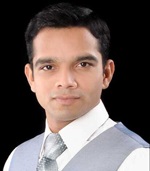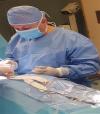Suggest Treatment For Symptoms Of Hirayama Disease

Posted on
Sat, 10 Oct 2015
Medically reviewed by
Ask A Doctor - 24x7 Medical Review Team
 Sat, 10 Oct 2015
Answered on
Sat, 10 Oct 2015
Answered on
 Tue, 3 Nov 2015
Last reviewed on
Tue, 3 Nov 2015
Last reviewed on
Question : I am convinced that my 17 year old son has Hirayama's Disease. His neurologist says he thinks it is ALS. Please help us.
Brief Answer:
ALS unlikely at that age, more information needed.
Detailed Answer:
Hello and thanks for using HCM.
I have read your question and understand your concerns.
Amyotrophic lateral sclerosis is very unlikely to happen in your son's age, Hirayama disease is a condition that may be diagnosed at that age, however, I need to ask you for more information about your son's condition such detailed description of symptoms and signs ( duration, distribution, relieving and worsening factors etc.), imaging studies that you may possess (x-rays, MRI of cervical spine, EMG).
Awaiting for further information.....,
ALS unlikely at that age, more information needed.
Detailed Answer:
Hello and thanks for using HCM.
I have read your question and understand your concerns.
Amyotrophic lateral sclerosis is very unlikely to happen in your son's age, Hirayama disease is a condition that may be diagnosed at that age, however, I need to ask you for more information about your son's condition such detailed description of symptoms and signs ( duration, distribution, relieving and worsening factors etc.), imaging studies that you may possess (x-rays, MRI of cervical spine, EMG).
Awaiting for further information.....,
Above answer was peer-reviewed by :
Dr. Sonia Raina


I do NOT believe my son has ALS. I believe that he has Hirayama Disease. His hand problem began almost 2 years ago at age 16. Now his right hand has atrophy and arm weakness. He is very thin. He recently had a growing spurt and grew about 3 inches taller. His little finger and the ring finger are separated from the rest of the fingers. He cannot write with a pencil anymore. His right hand has no strength anymore. This is a rare disease. It is not a motor neuron disease, but Hirayama is mistaken some times for ALS. His neurologist will not even consider Hirayama as the problem. He is a Quack, obviously. I know my son. He needs a neck brace, but I don't know what kind? Hirayama Disease happens when something is out of place in the neck and the spine grows very fast. Hirayama Disease attacks for maybe 4 years beginning at age 15 in young men and then does no more damage afterwards. The damage is done to the bottom 2 vertebrate of the spine, which is hard to detect in an MRI. Today his other hand (left hand) is shaking. Please help us. Nobody will help my son. Hirayama Disease is also known as juvenile muscular atrophy of distal upper extremity. Can you connect me with a neuromuscular specialist or a juvenile neurologist who has treated Hirayama Disease?
His MRI came back normal because they did not look at the bottom 2 inches of his spine, nor did they do any neck flexion pictures. The problem is in his neck. They did an EMG and he shows weakness and a tremor in both arms. All blood work comes back normal -- no HIV, etc. Hirayama Disease used to be only a disease in Japan. It is very undiagnosed and misdiagnosed in the United States. Please help us? What do I do? He hand are shriveling up and nobody cares.
His MRI came back normal because they did not look at the bottom 2 inches of his spine, nor did they do any neck flexion pictures. The problem is in his neck. They did an EMG and he shows weakness and a tremor in both arms. All blood work comes back normal -- no HIV, etc. Hirayama Disease used to be only a disease in Japan. It is very undiagnosed and misdiagnosed in the United States. Please help us? What do I do? He hand are shriveling up and nobody cares.
Brief Answer:
Hirayama disease is the most likely condition.
Detailed Answer:
Welcome back and thanks for the clarifications.
In my opinion, your son's condition fits better into Hirayama than in ALS disease.
It is true that it is a rare condition, but cases of young adults not only Japanese, are diagnosed in Asia, Europe and North XXXXXXX as well.
Cause is thought to be narrowed spinal canal and repetitive injuries of spinal cord by flexion movements of neck.
Diagnosis consists on characteristic clinical findings that correlate with those observed in your son's and dynamic MRI of entire cervical cord with intravenous contrast enhancement ( gadolinium ).
Cervical collars that may help in this case are "Phyladelphia" and "Miami" collars that can be bought without prescription, I think.
You don't need to seek for a specialized Neurologist, just get another opinion by a more open minded one.
You can discuss also with your son's primary care Doctor about prescription and ordering the appropriate MRI study.
Hope I've been of help.
Let me know if I can assist you further.
Take care.
Hirayama disease is the most likely condition.
Detailed Answer:
Welcome back and thanks for the clarifications.
In my opinion, your son's condition fits better into Hirayama than in ALS disease.
It is true that it is a rare condition, but cases of young adults not only Japanese, are diagnosed in Asia, Europe and North XXXXXXX as well.
Cause is thought to be narrowed spinal canal and repetitive injuries of spinal cord by flexion movements of neck.
Diagnosis consists on characteristic clinical findings that correlate with those observed in your son's and dynamic MRI of entire cervical cord with intravenous contrast enhancement ( gadolinium ).
Cervical collars that may help in this case are "Phyladelphia" and "Miami" collars that can be bought without prescription, I think.
You don't need to seek for a specialized Neurologist, just get another opinion by a more open minded one.
You can discuss also with your son's primary care Doctor about prescription and ordering the appropriate MRI study.
Hope I've been of help.
Let me know if I can assist you further.
Take care.
Above answer was peer-reviewed by :
Dr. Raju A.T


My son had PANDAS when he was 10 and one of his tics was constant head tipping about 100 times per day for at least a year. He also twisted his neck trying to pop it a couple of times per day so to me that would explain the neck injury. Does he need to take an antinflammatory? Would that help in addition to the neck brace? Approximately how long would he have to wear the neck brace?
Brief Answer:
Long term use of neck brace, short term use of NSAID.
Detailed Answer:
Welcome back.
Antiinflamatory drugs could be used if there is associated pain and there are evident spinal cord damages.
However, since the minor trauma is suspected as cause of Hirayama, an Inflamatory process should be undergoing also, so short term use of ibuprofen eg. could be recommended.
Cervical collar should be used until disease process limitation or until there is evidence of stabilization in dynamic MRI. ( a couple of years )
Cervical collar should be applied during the day, it can be removed while sleeping, cervical muscles strengthening exercises should be applied too, avoiding neck flexion.
These issues should be discussed with your son's primary care Doctor.
Hope I helped you.
Best regards.
Long term use of neck brace, short term use of NSAID.
Detailed Answer:
Welcome back.
Antiinflamatory drugs could be used if there is associated pain and there are evident spinal cord damages.
However, since the minor trauma is suspected as cause of Hirayama, an Inflamatory process should be undergoing also, so short term use of ibuprofen eg. could be recommended.
Cervical collar should be used until disease process limitation or until there is evidence of stabilization in dynamic MRI. ( a couple of years )
Cervical collar should be applied during the day, it can be removed while sleeping, cervical muscles strengthening exercises should be applied too, avoiding neck flexion.
These issues should be discussed with your son's primary care Doctor.
Hope I helped you.
Best regards.
Above answer was peer-reviewed by :
Dr. Yogesh D


I took my son to Children's Mercy Hospital in Kansas City, Missouri today. We saw a pediatric neurologist. He said Hirayama is a Japanese disease. I don't think he had ever heard of it. He told me to leave my articles and he would try to read them over the weekend and call me if he thinks my son could possibly have this disease. He said it is more like MS or ALS. Next Wednesday we have an appointment at the Mayo Clinic in XXXXXXX Minnesota. How can I make someone believe me? Would a firm neck collar from a local medical store be better than nothing? XXXXXXX needs an MRI with his neck flexed and a lower spine MRI. Should we travel to Japan? Is Dr. Hirayama still alive and in practice? Do you know anyone in the U.S. that understands this disease? Will the Mayo Clinic be just as oblivious to this disease?
Brief Answer:
Start using cervical collar.
Detailed Answer:
Welcome back.
Certainly a neck collar should be used, at least, until the correct diagnosis is achieved.
Dr. Hirayama described first this condition about 60 years ago, but it is not a exclusively Japanese disease, it is true that is a rare one.
I don't think you need to travel to Japan, I believe that you will get a correct answer after the evaluation at Mayo clinic.
Multiple sclerosis makes sense and could be included in differential diagnosis, but not ALS.
I think it is Hirayama disease, but confirmation by flexion MRI is necessary.
Hope to hear good things from you soon.
Take care.
Start using cervical collar.
Detailed Answer:
Welcome back.
Certainly a neck collar should be used, at least, until the correct diagnosis is achieved.
Dr. Hirayama described first this condition about 60 years ago, but it is not a exclusively Japanese disease, it is true that is a rare one.
I don't think you need to travel to Japan, I believe that you will get a correct answer after the evaluation at Mayo clinic.
Multiple sclerosis makes sense and could be included in differential diagnosis, but not ALS.
I think it is Hirayama disease, but confirmation by flexion MRI is necessary.
Hope to hear good things from you soon.
Take care.
Above answer was peer-reviewed by :
Dr. Vinay Bhardwaj

Answered by

Get personalised answers from verified doctor in minutes across 80+ specialties



